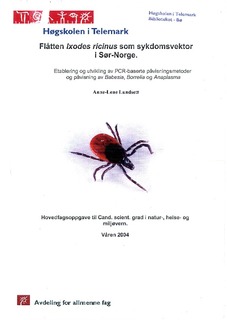| dc.description.abstract | NORSK SAMMENDRAG: Hensikten med denne undersøkelsen var å undersøke flåtten Ixodes ricinus som smittebærer av Ehrlichia/ Anaplasma, Borrelia burgdorferi sensu lata og Babesia i Sør-Norge, og å etablere DNA-basert metode for påvisning av Babesia og forbedre metode for påvisning av Ehrlichia/ Anaplasma. For å kontrollere variasjon i følsomheten av Ehrlichia/ Anaplasma PCR med 16s rDNA primere Ehr 521/747, ble en internkontroll konstruert. Internkontrollen er et DNA-fragment som kan amplifiseres med primerne Ehr 521/747. Dette gir et større amplifiseringsprodukt enn naturlig rDNA. En Real Time PCR-metode ble etablert til påvisning av Babesia, da en publisert konvensjonell PCR-metode ikke gav tilfredsstillende resultater. Real Time PCR fungerte for påvisning av Babesia divergens gruppen, men ikke for Babesia microti gruppen. I august 2000 ble 275 flått fra fylkene Telemark, Vest-Agder, Rogaland og Hordaland samlet inn for å undersøke frekvens og fordeling av smittebærende flått. I tillegg ble l00 flått fra august 1999 og 97 flått fra august 2001 fra Langøya, Telemark inkludert i undersøkelsen. DNA fra alle de totalt 472 flåttene ble ekstrahert og analysert for sykdomspatogener vha. polymerase chain reaction (PCR). 33 flått ble ekskludert fra undersøkelsen fordi de var hemmende for PCR-reaksjonen. Babesia ble påvist i en flått (0.23%), Ehrlichia/ Anaplasma i 78 flått (17.8%), og B. burgdorferi s.l. i 13 flått (3.2%). Kun 3 flått (0.86%) var bærere av to smittestoff samtidig. Det var en signifikant stigende trend fra august 1999 til august 2001 når det gjaldt forekomsten av Ehrlichia/ Anaplasma på Langøya, Telemark. Det var ingen signifikante forskjeller mellom de ulike fylkene eller mellom de ulike stadiene når det gjaldt forekomst av Ehrlichia/ Anaplasma. Forekomstene av B. burgdorferi s.l. og Babesia var for få til å kunne gjennomføre tilsvarende sammenligninger. Resultatet av denne undersøkelsen viste at utviklete metoder fungerer og er potensielt nyttige. Analyse av innsamlet flått viste svært lav smittefrekvens uten klar geografisk fordeling. ENGLISH SUMMARY: The intention with this project was to examine the tick Ixodes ricinus as a vector for Ehrlichia/ Anaplasma, Borrelia burgdorferi sensu lata and Babesia in Southern-Norway, and to establish DNA-amplification to detect Babesia and to improve the method to detect Ehrlichia/ Anaplasma. To control the variation in the sensitivity of Ehrlichia/ Anaplasma PCR with 16s rDNA primers Ehr 521/747, was an" internal control" designed. The "internal control" is a DNA fragment, which can amplify with the primers Ehr 521/7 4 7. This gives a larger DNA fragment than natural rDNA. A Real Time PCR method was established to detect Babesia, when a published conversely PCR-method did not give satisfactory results. This is the first detection of Babesia by genetic methods in Norway and the first Real Time PCR method for Babesia detection. Real Time PCR worked for detection of Babesia divergens, but not for detection of Babesia microti. In August 2000, 275 ticks from the counties Telemark, Vest-Agder, Rogaland and Hordaland were collected to examine the prevalence and the distribution of ticks as carrier of infection. Furthermore l00 ticks from August 1999 and 97 ticks from August 200l from Langøya, Telemark were included in this project. DNA from all the collected ticks was extracted and analyzed for pathogen with PCR. 33 ticks were excluded from this project because they were inhibitory for PCR-amplification. Babesia was detected in one tick (0.23%), Ehrlichia/ Anaplasma in 78 ticks (17.8%) and Borrelia burgdorferi s.l. in 13 ticks (3.2%). Only 3 ticks (0.46%) contained two pathogens. There was a significant increasing trend from August 1999 to August 2001 in occurrence of Ehrlichia/ Anaplasma at Langøya. There were no significant differences between the different counties or between the different instars for prevalence of Ehrlichia/ Anaplasma. The prevalence of Borrelia burgdorferi s.l and Babesia were too low to analyze statistical. This is the first use of Real Time PCR for detection of Babesia and the first study of the prevalence of Ehrlichia where an "internal control" was used. This methodological advances improved the ease of interpretative results and saved time. The analyses of collected ticks showed a low frequency of infection without clear geographic variation. | |
